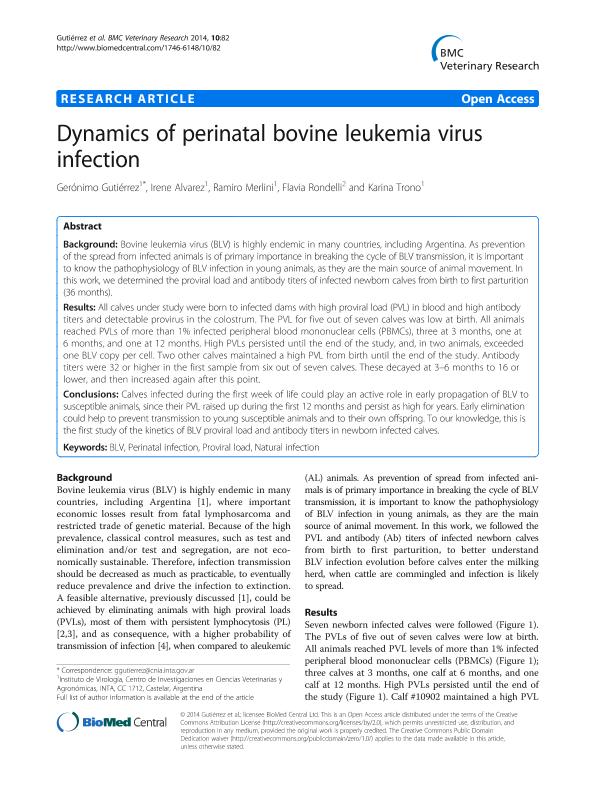Mostrar el registro sencillo del ítem
dc.contributor.author
Gutiérrez, Gerónimo

dc.contributor.author
Alvarez, Irene

dc.contributor.author
Merlini, Ramiro
dc.contributor.author
Rondelli, Flavia
dc.contributor.author
Trono, Karina Gabriela

dc.date.available
2018-01-18T15:04:10Z
dc.date.issued
2014-04
dc.identifier.citation
Gutiérrez, Gerónimo; Alvarez, Irene; Merlini, Ramiro; Rondelli, Flavia; Trono, Karina Gabriela; Dynamics of perinatal bovine leukemia virus infection; BioMed Central; BMC Veterinary Research; 10; 82; 4-2014; 82-87
dc.identifier.issn
1746-6148
dc.identifier.uri
http://hdl.handle.net/11336/33776
dc.description.abstract
BACKGROUND: Bovine leukemia virus (BLV) is highly endemic in many countries, including Argentina. As prevention of the spread from infected animals is of primary importance in breaking the cycle of BLV transmission, it is important to know the pathophysiology of BLV infection in young animals, as they are the main source of animal movement. In this work, we determined the proviral load and antibody titers of infected newborn calves from birth to first parturition (36 months).
RESULTS: All calves under study were born to infected dams with high proviral load (PVL) in blood and high antibody titers and detectable provirus in the colostrum. The PVL for five out of seven calves was low at birth. All animals reached PVLs of more than 1% infected peripheral blood mononuclear cells (PBMCs), three at 3 months, one at 6 months, and one at 12 months. High PVLs persisted until the end of the study, and, in two animals, exceeded one BLV copy per cell. Two other calves maintained a high PVL from birth until the end of the study. Antibody titers were 32 or higher in the first sample from six out of seven calves. These decayed at 3–6 months to 16 or lower, and then increased again after this point.
CONCLUSIONS: Calves infected during the first week of life could play an active role in early propagation of BLV to susceptible animals, since their PVL raised up during the first 12 months and persist as high for years. Early elimination could help to prevent transmission to young susceptible animals and to their own offspring. To our knowledge, this is the first study of the kinetics of BLV proviral load and antibody titers in newborn infected calves.
dc.format
application/pdf
dc.language.iso
eng
dc.publisher
BioMed Central

dc.rights
info:eu-repo/semantics/openAccess
dc.rights.uri
https://creativecommons.org/licenses/by/2.5/ar/
dc.subject
Blv
dc.subject
Perinatal Infection
dc.subject
Proviral Load
dc.subject
Natural Infection
dc.subject.classification
Otras Ciencias Veterinarias

dc.subject.classification
Ciencias Veterinarias

dc.subject.classification
CIENCIAS AGRÍCOLAS

dc.title
Dynamics of perinatal bovine leukemia virus infection
dc.type
info:eu-repo/semantics/article
dc.type
info:ar-repo/semantics/artículo
dc.type
info:eu-repo/semantics/publishedVersion
dc.date.updated
2018-01-16T18:03:49Z
dc.journal.volume
10
dc.journal.number
82
dc.journal.pagination
82-87
dc.journal.pais
Reino Unido

dc.journal.ciudad
Londres
dc.description.fil
Fil: Gutiérrez, Gerónimo. Instituto Nacional de Tecnología Agropecuaria. Centro de Investigación en Ciencias Veterinarias y Agronómicas. Instituto de Virología; Argentina. Consejo Nacional de Investigaciones Científicas y Técnicas; Argentina
dc.description.fil
Fil: Alvarez, Irene. Instituto Nacional de Tecnología Agropecuaria. Centro de Investigación en Ciencias Veterinarias y Agronómicas. Instituto de Virología; Argentina. Consejo Nacional de Investigaciones Científicas y Técnicas; Argentina
dc.description.fil
Fil: Merlini, Ramiro. Instituto Nacional de Tecnología Agropecuaria. Centro de Investigación en Ciencias Veterinarias y Agronómicas. Instituto de Virología; Argentina
dc.description.fil
Fil: Rondelli, Flavia. Universidad Nacional de Rosario. Facultad de Ciencias Veterinarias; Argentina
dc.description.fil
Fil: Trono, Karina Gabriela. Instituto Nacional de Tecnología Agropecuaria. Centro de Investigación en Ciencias Veterinarias y Agronómicas. Instituto de Virología; Argentina. Consejo Nacional de Investigaciones Científicas y Técnicas; Argentina
dc.journal.title
BMC Veterinary Research

dc.relation.alternativeid
info:eu-repo/semantics/altIdentifier/url/https://bmcvetres.biomedcentral.com/articles/10.1186/1746-6148-10-82
dc.relation.alternativeid
info:eu-repo/semantics/altIdentifier/doi/http://dx.doi.org/10.1186/1746-6148-10-82
Archivos asociados
